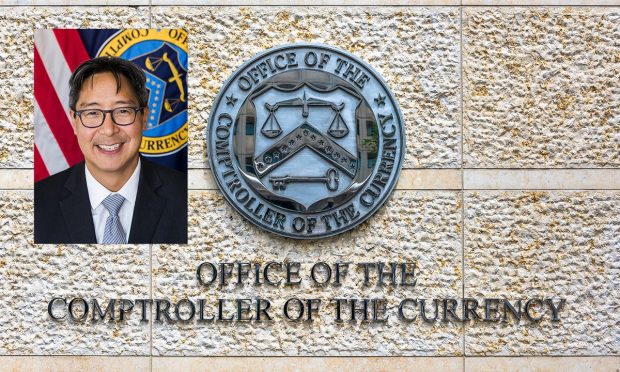OCC’s Hsu: Stablecoins Can Boost Innovation If Regulated Like Banks

There are a number of ways to read between the lines of the speech about stablecoins Acting Comptroller of the Currency Michael Hsu made at a financial conference today (Jan. 13).
One is, of course, he’s genuinely concerned about their potential to damage the economy. But that doesn’t preclude a power play.
Despite its broader title, Hsu’s talk about “The Future of Crypto-Assets and Regulation” at the British American Business Transatlantic Finance Forum on Jan. 13 focused mainly on stablecoins, a type of cryptocurrency that maintains a peg with the U.S. dollar — or other fiat currencies — by backing its tokens one-to-one with dollars and other highly liquid investments.
One big difference from previous comments was that he’s beginning to see stablecoins as an instrument that can have a useful place in the financial market. Or at least he is accepting that it is going to be.
After a laundry list of signs that “crypto has rapidly gone mainstream” that ranged from its $2 trillion market cap and the growing non-fungible token (NFT) craze to crypto’s widespread adoption among underbanked and minority consumers, Hsu said something new.
“Bank regulation would give credibility to the ‘stable’ part of stablecoins,” he said. “Regulating stablecoin issuers as banks could also enable more innovation in crypto and make those innovations more durable.”
Read more: The Stablecoin Problem
Which is a fair distance from comments he made two months ago on CoinDesk TV, where he said the constantly evolving nature of cryptocurrencies “is not what you want” from stablecoins.
“You want your money to be stable and reliable; you want it to be there in good times and bad times and not have to think about it,” said Hsu. “If you innovate too much in that space, you’re going to get a wide range of outcomes … some of which are not going to be good.”
Speaking at the Forum, Hsu called the broader crypto market “exciting” and added that it “presents a host of opportunities for banks” before noting that “the risks, the pace of change, and the lack of standards and controls in the crypto space suggest that a cautious and careful approach is warranted.”
The biggest risk he sees is potential for a run on cryptocurrencies similar to the one that drove Bear Stearns under in 2008 — a run he saw first-hand from positions at the Securities and Exchange Commission and Treasury Department. He spoke on the hows that boiled down to if buyers lose faith in one stablecoin’s ability to redeem its tokens for fiat, there very well could be a run on all. Even ones that are, as bankers, treasurers and risk-managers bemoaned in 2008, “money good.”
See also: Sen. Warren Calls DeFi the ‘Most Dangerous’ Part of Crypto at Senate Hearing
His words are still far from the position U.S. Sen. Elizabeth Warren (D-MA) took at the Senate Banking Committee’s stablecoin hearing on Dec. 13, when she prodded ahead of an anti-crypto witness who called for a ban on stablecoins.
Read also: Hong Kong Monetary Authority Calls Stablecoins Crypto’s Greatest Threat
He highlighted stablecoins’ vital role in the crypto trading world, calling them “the oxygen of the crypto ecosystem” and highlighting their “critical role in supporting and facilitating rapid growth in decentralized finance” or DeFi.
Elbow Room
So what’s it all about? One possible answer is that he’s elbowing his way into the fight between the SEC and Commodity Futures Trading Commission — the CFTC — over who will get control now that congress is finally getting serious about regulating crypto.
Read more: In 2021, Crypto Got Ready for Its Closeup
Noting that runs are destructive like hurricanes in that they do not discriminate “between those who deserve to bear losses and those who are innocent,” he pointed out that this was particularly true of shadow banks in 2008.
“A stablecoin run would not just impact those directly invested in it,” Hsu added. “There would be collateral damage … and that damage will continue to grow as long as crypto expands.”
Fortunately, he said, there is an effective tool to mitigate those risks: Bank regulation, which Hsu said, “would give credibility to the ‘stable’ part of stablecoins.”
That would give investors confidence that even in crisis, “the reserves would be there, overseen and examined by bank supervisors, and potentially even backstopped” by the central bank.
That’s when Hsu worked his back innovations, arguing that “regulating stablecoin issuers as banks could also enable more innovation in crypto and make those innovations more durable.”
He added, “While innovation thrives in uncertain environments, solid foundations can help, especially when it comes to money and trust.”